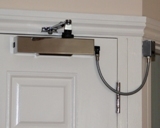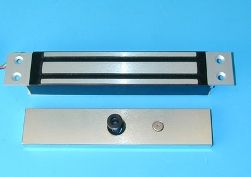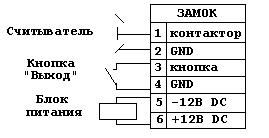Electromagnetic locks
 For unauthorized access to the premises, such a device as a lock was invented a long time ago. The electromagnetic lock is one of the varieties of this family of devices. It has high reliability, insensitivity to aggressive environment, resistance to temperature extremes, which is important in operating conditions in our country.
For unauthorized access to the premises, such a device as a lock was invented a long time ago. The electromagnetic lock is one of the varieties of this family of devices. It has high reliability, insensitivity to aggressive environment, resistance to temperature extremes, which is important in operating conditions in our country.
There are no rubbing parts in the design of such a lock. This increases its durability and makes it almost the only solution for doors that are installed in sites with high traffic (educational institutions, factories). The electromagnetic lock is a great option for fire doors and emergency exits. Because, in the event of an evacuation, it can be easily opened with the push of a button, or it will open by itself when the building shuts down. Such a lock cannot be opened with a master key.
Types of electromagnetic locks
 Electromagnetic locks are divided according to the type of work into two groups: retaining and sliding. When holding electromagnetic locks, the armature works for separation, for shear locks - in cross-section, for shearing. Both these and others are most often marked with the designation «ml».After this designation, through a dash, there is a designation of the pulling force in kilograms. For example, electromagnetic lock ML-100K. This means an electromagnetic lock with a pull force of 100 kg.
Electromagnetic locks are divided according to the type of work into two groups: retaining and sliding. When holding electromagnetic locks, the armature works for separation, for shear locks - in cross-section, for shearing. Both these and others are most often marked with the designation «ml».After this designation, through a dash, there is a designation of the pulling force in kilograms. For example, electromagnetic lock ML-100K. This means an electromagnetic lock with a pull force of 100 kg.
By control, the locks are divided into: controlled with electronics and without electronics. In the second case, the door opens simply by pressing a button and locks when closed. If electronics are used, this can be a Hall sensor or magnetic contact sensors (reed switches). A lock can contain all types of management and control.
Electromagnetic retention locks
The retaining electromagnetic lock (ml) is usually an invoice (exception, narrow lock). It can be installed on the bottom, side or most often on top of the door. This is not very convenient, since the overlay reduces the door. In addition, an attempt to open a door fixed, for example, only from above, can lead to deformation of the door.
A narrow electromagnetic door lock can also be installed anywhere, but is usually placed in the middle. This does not reduce the door because it is a cut-in. But there are installation restrictions. Because the working surface of the anchor will not be able to withstand a large force. Therefore, it is installed in thin doors, where the use of great efforts is excluded: doors for furniture, showcases, fire cabinets, hatches, technological plugs, etc. However, to enhance the effect, several locks can be installed, with one control.
Sliding electromagnetic locks
The sliding electromagnetic lock is usually a mortise. Therefore, such an electromagnetic door lock is usually installed in the middle. It, like a narrow lock, does not block the door.The electromagnet in it does not work directly, as in the holder, but to displace the tongue that locks the door.
Electromagnetic locks with built-in sensors
 Hall sensors and magnetic contact sensors have different purposes. Hall sensors control the actuation of the lock and magnetic contacts control the closing of the door.
Hall sensors and magnetic contact sensors have different purposes. Hall sensors control the actuation of the lock and magnetic contacts control the closing of the door.
A Hall sensor responds to a magnetic field. This sensor is usually a Hall sensor with a digital output. Since there are only two positions (1 or 0), then the control voltage at the output is either present or not. The load in such circuits is of small size reed relay… It turns on when the magnetic field rises (the lock is closed) and turns off when it falls. Conveniently, the sensor is located in the body of the electromagnetic door lock. And it is impossible to determine if there is a Hall sensor on the outside or not.
A sensor for magnetic contacts (reed switch) monitors the position of the door. It works autonomously, regardless of the operation of the lock or Hall sensor. Unlike the Hall sensor, it does not need power, it is a passive sensor. It is convenient that it can be installed both together with an electromagnetic lock (easier) and separately.
The principle of operation is based on the actuation (closing) of a reed switch in a magnetic field. The circuit breaker should be in the back, but on the contrary, the door should be permanent magnetoriented with respect to the reed switch. When the door is closed, the reed switch closes under the influence of the magnetic field. When the door was opened, the magnetic field "disappeared", the reed switch opened.
Both sensors can use their free contacts to connect to any control, monitoring or security system. Can be used together or separately. In addition, the Hall sensor can signal a decrease in the force of gravity and the need for prevention.
Installation problems
 Both types of electromagnetic locks have their pros and cons. Including installation. A deadbolt lock is easier to install than a mortise lock as it is placed from the outside. There is no need to drill, dig the cavity in either the casing or the door to install the lock. Installation of an electromagnetic lock begins with marking. It is necessary to determine the optimal location of the castle.
Both types of electromagnetic locks have their pros and cons. Including installation. A deadbolt lock is easier to install than a mortise lock as it is placed from the outside. There is no need to drill, dig the cavity in either the casing or the door to install the lock. Installation of an electromagnetic lock begins with marking. It is necessary to determine the optimal location of the castle.
As already mentioned, most often a locking lock is placed on top. This is explained by the fact that it closes part of the door, and installing it in another place will interfere with the passage.
First, stick the provided sticker with the markings on the back where the lock will be installed. Holes for fastening are drilled on it. After that, the cover is installed, the wires are connected and connected, the lock itself is attached. An anchor is then placed on the door opposite the lock. Anchor anchoring is designed in such a way that it holds the door under the load for which the electromagnetic lock is designed. Often for this, the fastener passes through the door and is fastened on the back side with nuts.
Before installing the sliding lock, you need to make sure that the gap between the door and the shutter in the place where the lock will be installed is small enough. The tongue of the lock must cover it completely.In addition, mortise locks are very demanding in terms of matching the lock on the back and the door strike plate. Deviation in any direction (up and down, left and right, front and back) can lead to the fact that the «electromagnetic lock» will not block the door.
To ensure the required accuracy, the lock kit includes special adjusting plates, the locking plate and the striker plate are equipped with adjusting screws. This is done in case the door is deformed, the wall is moved or the bracket is bent during operation. These adjusters will allow you to adjust the position of the latch and strike plate so that the door is locked.
Connection with electromagnetic lock
When connecting an electromagnetic lock, it matters which of the two options is controlled: with a built-in controller or without electronics. In the second case, the connection scheme will be very simple (Fig. 1). It consists of an electromagnetic coil L to which a voltage U is applied and a button to close the circuit S. But in this case the door will be controlled by only one button.
Much more complicated is the wiring diagram for an electromagnetic lock controlled by an electronic controller. The controller can be external or internal. The presence of the controller allows the use of proxy cards, memory touch keys and other similar means to individually open the door. Please note that the "exit" button (fig. 2) must be open in the normal position. In this case, the controller stores information about electronic identifiers.

Rice. 1.

Rice. 2.
For the installation and maintenance of electromagnetic locks, it is better to invite a specialist. The most detailed instruction is unlikely to replace experience and qualification. It is best to consult him on the choice of castle on a case-by-case basis.
